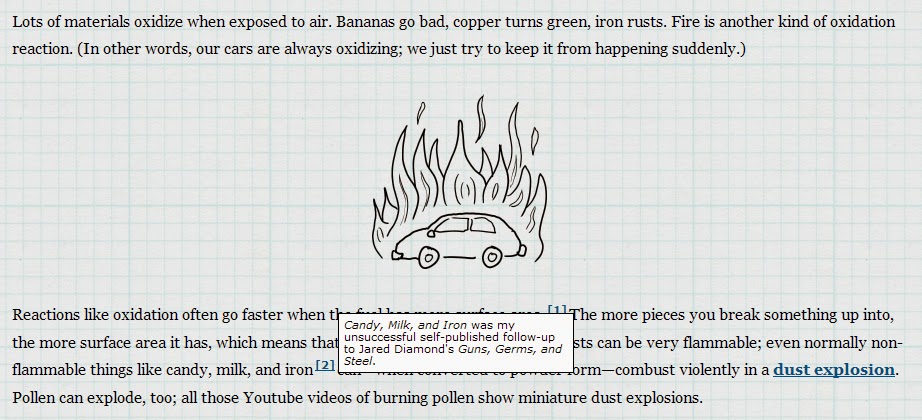Questions and scenarios the site has covered include...
and the classic...
(That last one is a favorite of mine. In this scenario, everyone is transported to Rhode Island (the home of the Griffin family (and everyone else in Family Guy)) and after explaining what happens when they jump, he then explains the chaotic carnage that results when you transport everyone on Earth to the same place. Yelp, Randall thinks of the bits others neglect to think about.)
It was while reading one in that went out in May 2014 (What if all the pollen in the sky suddenly ignited?) that I found this text window....
screengrab from What if? page of xkcd (May 2014)
For those who can't make out the text, it says....
"Candy, Milk, and Iron was my unsucessful self-published follow-up to Jared Diamond's Guns, Germs, and Steel."Guns, Germs, and Steel is a Pulitzer Prize winning non-fiction book by American science polymath Jared Diamond. It was so good that National Geographic produced a documentary based on it in 2005.
It will take me ages to explain in detail what the book is about, but I can sum it up in a way. It is about how a number of factors, from climate and geography to farming and technology, allowed the "civilizations" of Eurasia (plus Africa and the Americas) to become what they are and dominate the "primitive" tribes. The title references three key factors in his argument. The guns represent military superiority through more advanced weapons. The germs represent the diseases that tribes that mastered domestication got exposed to, became immune to, and then (unintentionally most of the time, due to lack of knowledge of bacteria and viruses) used to wipe out "inferiors." And finally, the steel represents more robust transport systems, such as roads and railways.
(Please note: While writing this I have never read the book or seen the documentary, but I do get (from reading the Wikipedia page) the "jist" of Jared Diamond's argument, as I have done my own research and thinking on history, and I have come to similar conclusions. But please don't take my words as the "final word" on the subject. Look at other arguments too before you decide your own conclusions.
Also, I don't believe in the distinction between "civilizations" and "primitive" tribes. "Civilization" is a word used too much as a term of segregation by people who think themselves as "civilized" and refer to everyone else as "barbarians.")
It's a simple title. A title that (cryptively) describes what it is about. But such a title can be easily abused. Any list of three random things can became a pseudo-title of a similar book... like Candy, Milk and, Iron. With such a book title (which can be open to interpretation) and the huge scope of the original book, its the sort of book you'll imagine someone like Randall Munroe would write (if he wasn't busy drawing stick figurines).
But, if he'd ever try to do so, here's an idea for the cover (this is the reason why this joke picked my interest). Using the most recent cover design of the book as inspiration....
Most recent book cover for Guns, Germs, and Steel
(still available in most bookshops that sell science books (or Amazon))
Here's my design for Candy, Milk, and Iron....
Its a bit rushed, but this is a proof of concept work. I didn't have access to an x-ray machine so I had to manipulate my photos by inverting them, solarizing them and turning them monochrome. But the effect is similar.
This may be the first of a series of fictional book covers, so watch out for more.....




No comments:
Post a Comment